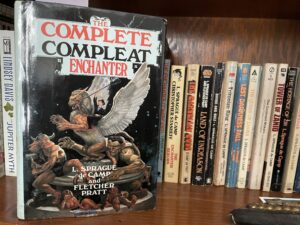
I re-read books. Yes, I keep going back to the well, or, rather, wells. But if the water is so good — uisce beatha, if you will — what’s wrong with that?
I have the Baen edition of L. Sprague de Camp and Fletcher Pratt’s The Complete Compleat Enchanter, which I haven’t read in years. More fool me. It contains the sequentially connected (Short novels? Novellas? I haven’t peformed word counts.) stories The Roaring Trumpet, the Mathematics of Magic, The Castle of Iron, The Wall of Serpents, and The Green Magician. As noted in David Drakes introduction (highly recommended) these were originally published in John W. Campbell’s magazine Unknown, wherein the writing credits were reversed. (Campbell gets a cameo of sorts in Mathematics of Magic.)
So far this week I’ve read through the first two. (Hence, the “Part One” of the title of this post.) The first thing I want to note is the pacing. It is brisk. I find myself breezing through these stories faster than most fiction I pick up nowadays. It’s as if I’m getting to return to the Ken Lizzi of bygone days who had the time and lack of competing demands that allowed him to sit down and read two or three hundred pages in a day. Sure, I’m not reading that fast. Contemporary Ken Lizzi does have those competing demands on his time. Messrs. Pratt and de Camp keep the story moving along, providing all the information and background color the reader needs but not a word more. That allows room for the jokes.
That’s the second thing to note. These stories are funny. Droll might be a better word. But definitely some variety of amusing. On occasion rather boldly amusing for the era. (I finally got around to reading The Ballad of Eskimo Nell, of which Harold Shea, the hero of the stories, quotes a few carefully selected snatches in Mathematics of Magic. Even though redacted, the fact that the doggerel was referenced at all seems rather audacious for the 1940s.) Pratt and de Camp are able to find humor in the Norse myths and Spencer’s Faerie Queene without belittling or mocking the source material.
And they get the source material. They also ground it, looking at the practicalities that would have necessarily accompanied these worlds. I mean, of course they would; this is L. Sprague de Camp writing for John W. Campbell. The nuts and the bolts must be considered. In fact the nuts and the bolts must take primacy of place. Specifically in the Harold Shea stories these nuts and bolts are the workings of the magic system in each world into which the characters transport themselves. (That method of transport provides the initial piece of “science” developed in the narrative.)
Roaring Trumpets takes place at the cusp of Ragnarok. Shea ends up there accidentally, rather than hitting the world of the Irish Mythos he’d been attempting for. Shea is rather a bumbler in this first tale, getting frequently taken down a peg. It is a learning experience for him. And learn he does, for by The Mathematics of Magic (taking place in the quasi-Arthurian/chanson de geste-esque sylvan landscapes of the Faerie Queene) he has grown in confidence and competence, becoming more of the conventional hero he’d considered himself to be.
It’s good stuff. Fun. I’ll be plowing straight on through the rest of the series. If you haven’t already, you might want to give it a try. You might also want to try the Semi-Autos and Sorcery series. I think that’s pretty good, too. Then again, I am biased.

1 comment